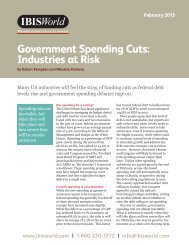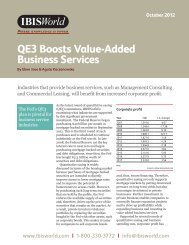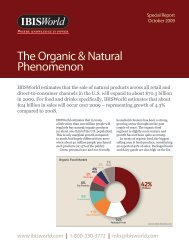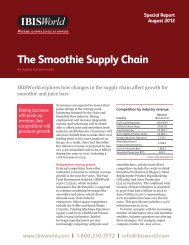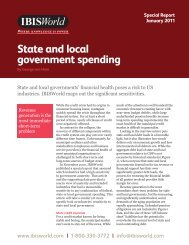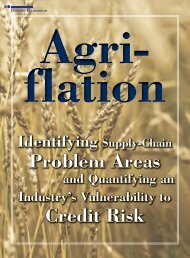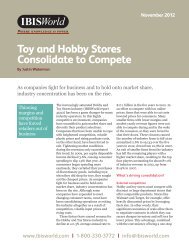Wedding Industry - IBISWorld
Wedding Industry - IBISWorld
Wedding Industry - IBISWorld
You also want an ePaper? Increase the reach of your titles
YUMPU automatically turns print PDFs into web optimized ePapers that Google loves.
Table 1<br />
<strong>Wedding</strong>-related Accommodation and Food Services Industries<br />
Growth<br />
Reception: Related Industries 2007-2009 2010 2009-2012<br />
Hotels & Motels -3.1% 1.3% 3.0%<br />
Single Location Full-Service Restaurants -2.8% 3.1% 2.9%<br />
Chain Full-Service Restaurants -2.4% 3.1% 2.6%<br />
Bars, Nightclubs & Drinking Establishments -5.3% 1.1% 2.6%<br />
Caterers -0.8% -1.1% 1.7%<br />
Bed & Breakfast & Hotel Accommodations -3.8% 0.5% 1.3%<br />
Table 2<br />
<strong>Wedding</strong> Attire Industries<br />
Related <strong>IBISWorld</strong> Industries<br />
Growth<br />
Source: <strong>IBISWorld</strong><br />
<strong>Wedding</strong> Attire: Related Industries 2007-2009 2010 2009-2012<br />
Clothing Accessories Stores 0.7% 3.8% 5.3%<br />
Hair & Hair Salons -3.0% 2.0% 2.6%<br />
Lingerie, Swimwear, Uniform & Bridal Stores -10.2% 1.2% 2.3%<br />
Women’s Clothing Stores -4.7% 1.3% 1.5%<br />
Shoe Stores -5.0% 0.2% 1.4%<br />
Formal Wear & Costume Rental -.07% -3.0% -1.1%<br />
Men’s Clothing Stores -4.2% -2.6% -1.5%<br />
Department Stores -5.3% -1.5% -2.5%<br />
Table 3<br />
<strong>Wedding</strong> Ring and Flower Industries<br />
Growth<br />
Source: <strong>IBISWorld</strong><br />
<strong>Wedding</strong> Rings & Flowers: Related Industries 2007-2009 2010 2009-2012<br />
Jewelry Stores -4.6% -0.8% 1.2%<br />
Florists -7.4% -1.4% -0.6%<br />
Source: <strong>IBISWorld</strong><br />
that an estimated 30% of this industry’s revenue comes from<br />
suit and tuxedo rentals for weddings. <strong>IBISWorld</strong> has identified<br />
the growth in cheap imports from China as one of the<br />
greatest threats to this industry. More men are purchasing<br />
these imports instead of renting their attire as the price<br />
difference between renting and buying diminishes. As a<br />
result, risks for the formal-wear industry have heightened<br />
over the past few years, something financial lenders need<br />
to be aware of if they intend to serve this sector.<br />
Consistent with most retail operations, the need to adequately<br />
control stock on hand has become increasingly<br />
important to the health and viability of individual operators.<br />
Thousands of retail businesses have experienced considerable<br />
financial losses due to deep discounting and slumping<br />
retail profits over the past several years. The margin of error<br />
between an oversupply of inventory during bad times and<br />
a shortage of inventory during good times is crucial to the<br />
financial health of any single operator.<br />
<strong>Wedding</strong> Rings and Flowers<br />
Two more sectors—rings and flowers—also fall within the<br />
retail spectrum of industry analysis. The jewelry market<br />
has long been considered one of the higher-risk industries<br />
in the United States, receiving a very high risk rating from<br />
<strong>IBISWorld</strong>. Over the next 18 months, however, industry risk<br />
will fall into the medium-to-high risk band. The lowered<br />
risk is attributable to improving economic conditions, an<br />
expected decline in unemployment, rising per capita disposable<br />
income, and a stronger wedding market.<br />
The jewelry industry is characterized by very high and<br />
increasing levels of competition, but it has a profit margin<br />
of 10.4%, well above the 7.5% average for the retail sector<br />
as a whole. Jewelry markets are in a strong position to<br />
maintain and grow operations, but lenders must ensure<br />
that profit margins are not jeopardized by the high levels<br />
of competition in this industry.<br />
On the other hand, the florist market is expected to have<br />
a high risk rating in the next 18 months, given that it faces<br />
strong competition from the supermarket and grocery store<br />
industry. Florists will need to focus on individual retailing<br />
segments and special occasions to improve their overall<br />
competitive position. Accounting for about 55% of industry<br />
revenue, cut-flower arrangements represent a major segment<br />
for florists. For those specializing in weddings, this<br />
segment often can generate more than 80% of revenue.<br />
Additionally, the margins associated with a wedding are<br />
very rewarding for businesses that can control stock levels<br />
and implement high levels of quality control. Nonetheless,<br />
having all your eggs in one basket is a high-risk/high-reward<br />
approach for a florist. A look at the history of key sales and<br />
their consistency throughout the year will help minimize<br />
lending risk in this category (Table 3).<br />
Photography<br />
<strong>Wedding</strong>s are the primary source of revenue within the<br />
photography industry, generating 45.5% of industry revenue.<br />
There are no obvious large players in this segment.<br />
Operators generally service specific geographic regions—<br />
from low-cost, part-time photographers to elite, high-end<br />
service providers. These businesses have low start-up costs<br />
and investment requirements, making them a successful<br />
lending proposition. They do not require a great deal of cash<br />
to finance their operations, which reduces lending risk.<br />
<strong>Wedding</strong> photography has been one of the fastest growing<br />
segments in the photography industry in recent years.<br />
The average expenditure on photography for an American<br />
26<br />
December 2010–January 2011 The RMA Journal



